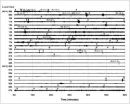(Press-News.org) COLUMBUS, Ohio - In two separate studies, researchers at The Ohio State University Wexner Medical Center have discovered a new class of treatment against methicillin-resistant Staphylococcus aureus (MRSA) as well as evidence of a growing need to quickly genotype individual strains of the organism most commonly referred to as the "superbug."
"The public is most familiar with the dramatic progression of skin infections caused by MRSA, but MRSA is responsible for a range of difficult to treat illnesses," noted Dr. Kurt B. Stevenson, an infectious disease expert at Ohio State, and primary investigator of one of the studies following the transmission of MRSA infections in communities published this month. "While we've seen a decrease in the number of MRSA cases, identifying new drug treatments and tracking methods will be critical to stopping these infections before they can start."
In the August issue of Bioorganic and Medicinal Chemistry, researchers detail the results of a study that began 10 years ago, when Ching-Shih Chen, professor of medicinal chemistry at Ohio State College of Pharmacy, and a team of researchers were creating a library of anti-cancer agents built around the scaffold of the molecules of celecoxib, a popular arthritis treatment in a family of drugs known as cyclooxygenase-2 (COX-2) inhibitors. This effort yielded OSU-03012 (AR12), a compound that is currently in a Phase I clinical trial as an anticancer agent at the OSU Comprehensive Cancer Center – Arthur G. James Cancer Hospital and Richard J. Solove Research Institute.
After observing how OSU-03012 acted within breast cancer cells, Hao-Chieh Chiu, a then postdoctoral researcher in Chen's laboratory, realized that the derivatives were suppressing a mechanism that bacteria use to take over their host cells. Chiu decided, with the support of Dr. Chen, to focus his research on testing this compound library against a variety of bacteria.
"When these compounds showed anti-bacterial activity against Salmonella and Francisella, we began testing efficacy against a variety of pathogenic bacteria, including Staphylococcus aureus, Enterococcus, and Streptococcus," said Chiu, who is now an assistant professor at the Department of Clinical Laboratory Sciences and Medical Biotechnology at National Taiwan University. "It became clear that these analogues had a unique anti-bacterial activity, and they appeared to be most potent against Staph aureus and other MRSA strains."
The researchers narrowed the library down to a single agent (dubbed "compound 46") and moved to testing in MRSA-infected mice. The authors report that an intraperitoneal administration of compound 46 resulted in increased survival in MRSA-infected mice versus untreated mice.
"It was particularly gratifying to see that these compounds, originally designed as anticancer agents, work as a novel class of anti-bacterial agents based on the same principle in bacterial cells," said Chen.
The insights provided by this early research helped a team of scientists from the Ohio State College of Pharmacy, College of Medicine and College of Veterinary Sciences win a $1.4 million grant from the National Institutes of Health (NIH) to investigate optimal ways to deliver a celecoxib-derived antibiotic to host cells infected by various pathogens, including drug-resistant tuberculosis.
MRSA DNA tells scientists where it's been – and where it might go next
Investigators in the Division of Infectious Diseases at the Ohio State College of Medicine have created a statewide "roadmap" of MRSA infections that is helping them better predict how – and where – MRSA will spread.
The team, funded by the Centers for Disease Control and Prevention (CDC), used diverse methods from geographic analysis to molecular genotyping to track more than 1,000 MRSA cases from the Wexner Medical Center and community hospitals across Ohio. Experts say using a variety of tracking methods is essential to stopping infections before they start.
"With data from different sources, we've markedly improved our understanding of how MRSA is acquired and then spread among healthcare facilities. For example, we identified a very rare strain in the US, ST-239, which originated in Asia, spread to hospitals in Western Europe, and was introduced to Ohio sometime in the past two decades. It's that level of knowledge that will help us change the course of transmission," said Stevenson, whose research on ST-239 and its presence in healthcare facilities was published online in the October issue of Emergent Infectious Diseases.
Stevenson's team has also applied these tracking methods to bloodstream isolates from hospitals in Franklin County, Ohio, as well as skin and soft tissue infections among patients receiving primary care in a variety of settings. The results not only demonstrated the value of rapid molecular typing in examining the distribution and transmission of individual MRSA strains, but showed that particular strains tended to cluster in specific places.
"These studies have demonstrated that specific molecular types of MRSA are linked to specific types of infections, or even specific settings. For instance, there are strains that tend to colonize catheters, strains that are more commonly found in nursing homes," said Shu-hua Wang, assistant professor of infectious disease. "As we understand why certain MRSA strains behave as they do, more targeted interventions for prevention and treatment can be tested."
Stevenson is hopeful that technology will someday provide a quick and inexpensive on-site genomic analysis of MRSA. In anticipation of that day, the team is using the "roadmap" data to create a MRSA molecular library that provides a detailed background on individual strains, including its drug resistance, weaknesses, and most likely source of transmission.
"We're envisioning a future where every patient admitted into a hospital will get a rapid, strain-specific MRSA test and within minutes, a doctor will know exactly what protocol to follow to stop the patient from getting sick, and stop the bacteria from spreading," said Stevenson.
###
Both the drug development and community tracking studies were funded by the Ohio State Center for Clinical and Translational Science (CCTS) with a goal of increasing the MRSA knowledge-base from both a basic science "bench" perspective, as well as using real-time data from infected communities to determine how the virulent bacteria spreads.
MRSA researchers identify new class of drug effective against superbug
Cancer research leads scientists to a MRSA killer
2012-10-09
ELSE PRESS RELEASES FROM THIS DATE:
Young people need financial support and guidance when they age out of foster care, MU expert says
2012-10-09
COLUMBIA, Mo. – As the economy and job market continue to recover, many young adults have moved in with their parents to save money. For teens and 20-somethings who grew up in foster care, saving money is especially difficult because they have aged out of a system that provided support in earlier years and lack important family ties they can depend upon, particularly as they enter adulthood and embark on their own. Now, a University of Missouri child welfare expert says youths in foster care need financial education and support to build assets so they can become financially ...
A welcome predictability
2012-10-09
Synthetic biology is the latest and most advanced phase of genetic engineering, holding great promise for helping to solve some of the world's most intractable problems, including the sustainable production of energy fuels and critical medical drugs, and the safe removal of toxic and radioactive waste from the environment. However, for synthetic biology to reach its promise, the design and construction of biological systems must be as predictable as the assembly of computer hardware.
An important step towards attaining a higher degree of predictability in synthetic biology ...
Wireless data at top speed
2012-10-09
Whether it's a wedding, birthday party or other celebration, these days the chances are you'll have your camcorder with you to record the great occasion. But we often forget to bring the data cable along with us, so despite promising the hosts to transfer the images to their computer the morning after, we hardly ever do. "No problem," we say, "I'll burn you a CD when I get home." It would be so much easier, though, to transfer the data wirelessly.
This thought also occurred to Frank Deicke, a researcher at the Fraunhofer Institute for Photonic Microsystems IPMS in Dresden. ...
App protects Facebook users from hackers
2012-10-09
RIVERSIDE, Calif. (www.ucr.edu) — Cyber-crime is expanding to the fertile grounds of social networks and University of California, Riverside engineers are fighting it.
A recent four-month experiment conducted by several UC Riverside engineering professors and graduate students found that the application they created to detect spam and malware posts on Facebook users' walls was highly accurate, fast and efficient.
The researchers also introduced the new term "socware" to describe a combination of "social malware," encompassing all criminal and parasitic behavior on online ...
Fossil of ancient spider attack only 1 of its type ever discovered
2012-10-09
CORVALLIS, Ore. – Researchers have found what they say is the only fossil ever discovered of a spider attack on prey caught in its web – a 100 million-year-old snapshot of an engagement frozen in time.
The extraordinarily rare fossils are in a piece of amber that preserved this event in remarkable detail, an action that took place in the Hukawng Valley of Myanmar in the Early Cretaceous between 97-110 million years ago, almost certainly with dinosaurs wandering nearby.
Aside from showing the first and only fossil evidence of a spider attacking prey in its web, the piece ...
Poorer lung health leads to age-related changes in brain function
2012-10-09
COLUMBUS, Ohio – Keeping the lungs healthy could be an important way to retain thinking functions that relate to problem-solving and processing speed in one's later years, new research suggests.
While these two types of "fluid" cognitive functions were influenced by reduced pulmonary function, a drop in lung health did not appear to impair memory or lead to any significant loss of stored knowledge, the study showed.
Researchers used data from a Swedish study of aging that tracked participants' health measures for almost two decades. An analysis of the data with statistical ...
Computational model IDs potential pathways to improve plant oil production
2012-10-09
UPTON, NY - Using a computational model they designed to incorporate detailed information about plants' interconnected metabolic processes, scientists at the U.S. Department of Energy's Brookhaven National Laboratory have identified key pathways that appear to "favor" the production of either oils or proteins. The research, now published online in Plant Physiology, may point the way to new strategies to tip the balance and increase plant oil production.
The study focused on the metabolism of rapeseed, a crop grown primarily in temperate climates for the oil that accumulates ...
2010 Korea bomb 'tests' probably false alarms, says study
2012-10-09
This spring, a Swedish scientist sparked international concern with a journal article saying that radioactive particles detected in 2010 showed North Korea had set off at least two small nuclear blasts--possibly in experiments designed to boost the yields of much larger bombs. Shortly after, the pot was stirred with separate claims that some intelligence agencies suspected the detonations were done in cooperation with Iran. Now, a new paper says the tests likely never took place—or that if they did, they were too tiny to have any military significance. The new report, ...
'Wonder material' graphene could revolutionize cell phones, solar panels and more
2012-10-09
WASHINGTON, October 8, 2012 — Smart phones almost as thin and flexible as paper and virtually unbreakable. Solar panels molded to cover the surface of an electric or hybrid car. Possible treatments for damaged spinal cords. It's not science fiction. Those all are possible applications of a material known as graphene. This so-called "wonder material," the world's strongest (100 times stronger than steel) and thinnest (one ounce would cover 28 football fields), is the focus of a new episode of the ChemMatters video series. The video is at www.BytesizeScience.com.
The video, ...
A DNA-made trap may explain amyloidosis aggravation
2012-10-09
Rio de Janeiro, Brazil- Amyloidosis is a group of clinical syndromes characterized by deposits of amyloid fibrils throughout the body. These fibrils are formed by aggregates of proteins that have not been properly folded. Deposits of amyloid fibrils are found in a number of diseases, including Alzheimer's and Parkinson's diseases and type-2 diabetes. The amyloid deposits can be localized, as in the brain of Alzheimer's patients, or found spread through the body, as in amyloidosis related to mutations in the transthyretin gene.
The clinical meaning of amyloid deposits ...
LAST 30 PRESS RELEASES:
Making lighter work of calculating fluid and heat flow
Normalizing blood sugar can halve heart attack risk
Lowering blood sugar cuts heart attack risk in people with prediabetes
Study links genetic variants to risk of blinding eye disease in premature infants
Non-opioid ‘pain sponge’ therapy halts cartilage degeneration and relieves chronic pain
AI can pick up cultural values by mimicking how kids learn
China’s ecological redlines offer fast track to 30 x 30 global conservation goal
Invisible indoor threats: emerging household contaminants and their growing risks to human health
Adding antibody treatment to chemo boosts outcomes for children with rare cancer
Germline pathogenic variants among women without a history of breast cancer
Tanning beds triple melanoma risk, potentially causing broad DNA damage
Unique bond identified as key to viral infection speed
Indoor tanning makes youthful skin much older on a genetic level
Mouse model sheds new light on the causes and potential solutions to human GI problems linked to muscular dystrophy
The Journal of Nuclear Medicine ahead-of-print tip sheet: December 12, 2025
Smarter tools for peering into the microscopic world
Applications open for funding to conduct research in the Kinsey Institute archives
Global measure underestimates the severity of food insecurity
Child survivors of critical illness are missing out on timely follow up care
Risk-based vs annual breast cancer screening / the WISDOM randomized clinical trial
University of Toronto launches Electric Vehicle Innovation Ontario to accelerate advanced EV technologies and build Canada’s innovation advantage
Early relapse predicts poor outcomes in aggressive blood cancer
American College of Lifestyle Medicine applauds two CMS models aligned with lifestyle medicine practice and reimbursement
Clinical trial finds cannabis use not a barrier to quitting nicotine vaping
Supplemental nutrition assistance program policies and food insecurity
Switching immune cells to “night mode” could limit damage after a heart attack, study suggests
URI-based Global RIghts Project report spotlights continued troubling trends in worldwide inhumane treatment
Neutrophils are less aggressive at night, explaining why nighttime heart attacks cause less damage than daytime events
Menopausal hormone therapy may not pose breast cancer risk for women with BRCA mutations
Mobile health tool may improve quality of life for adolescent and young adult breast cancer survivors
[Press-News.org] MRSA researchers identify new class of drug effective against superbugCancer research leads scientists to a MRSA killer



